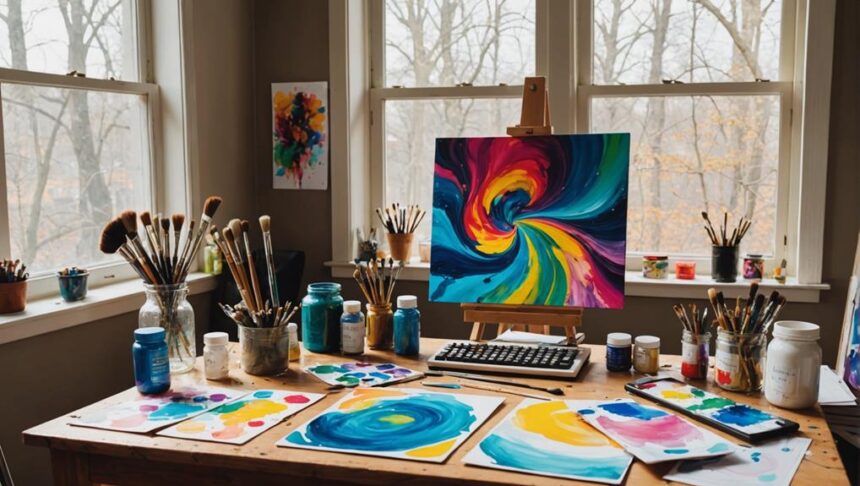Pricing your fluid art paintings can feel like cracking a tough code. First, tally up all your material costs—yes, even that pricey gold leaf you splurged on. Double it to cover your labor and overhead, then throw in extras like framing and shipping. Don't forget to compare prices with similar artists in your area or online. You're not just selling a painting; you're sharing a piece of your soul, so set prices that reflect your effort and emotional investment. Remember, adjusting prices based on demand and market trends is key to staying competitive—and this is just the beginning of mastering art pricing.
Key Takeaways
- Calculate total material costs and double them to cover expenses and ensure profit.
- Factor in hourly labor costs and time spent on each piece.
- Research market prices for similar works by artists at different experience levels.
- Include additional costs like framing, shipping, and gallery commissions in your pricing.
Understanding Art Value
Understanding the value of art begins with recognizing its inherently subjective nature, influenced by the artist's reputation, technique, and the emotional resonance it evokes in viewers.
When you look at a painting, it's not just about the colors and shapes; it's about how it makes you feel and what memories or thoughts it brings up. This is what we call art perception—the way individuals view and interpret art.
The emotional connection is key here. Imagine standing in front of a fluid art painting that reminds you of your childhood or evokes a sense of peace. That personal connection can make the artwork invaluable to you. Established artists often have a strong emotional impact on their audience, which can drive up the value of their work.
For emerging artists, building this emotional connection and understanding art perception is vital. It's not just about mastering technique but also about engaging viewers on an emotional level.
When people feel connected to your art, they're more likely to see its value. Pay attention to how people react to your work, and use this feedback to refine your approach, ensuring your art resonates deeply with your audience.
Pricing Formula Basics
Now that we've covered the basics of understanding art value, let's break down the essentials of pricing your fluid art paintings.
First, you'll need to contemplate the cost of materials, like paint and canvas, as well as the time and labor you've invested.
Don't forget to look at market comparisons to see how similar works are priced, ensuring your rates are competitive yet fair.
Cost of Materials
Calculating the total cost of materials is the foundational step in determining the appropriate price for fluid art paintings.
Start with material sourcing, identifying where to get the best-quality paints, canvases, and other supplies. Once you have your supplies, diligent cost tracking is vital. Keep a detailed record of how much you spend on each item. For instance, if you purchase a set of high-quality paints for £40 and canvases for £20, your total material cost is £60.
A practical rule of thumb is to double these costs to guarantee you cover all expenses and make a reasonable profit. So, if materials cost £60, your base price should be at least £120. But don't forget framing! If framing a piece costs £50, add that to your base price, making it £170.
While this might seem like a lot of math, it's essential for making sure you don't end up losing money. The accuracy of your material cost assessment can greatly impact your overall pricing strategy.
Time and Labor
Incorporating time and labor into your pricing formula is crucial for accurately valuing your fluid art paintings.
Time management plays a critical role here, as you need to account for every hour spent creating your masterpiece. For instance, if you charge £25 per hour and spend 10 hours on a painting, that's £250 just for your labor. Add in material costs, say £50, and you get a total of £300.
Labor intensity can't be ignored either. Larger pieces often require more effort, so logically, they should be priced higher. A common method is to price paintings by square inch, between $0.50 to $1.00. For example, a 480-square-inch painting might range from $240 to $480. This approach guarantees that both time and effort are adequately compensated.
Don't forget other costs like framing, shipping, and gallery commissions, which can eat into your profits.
Consistently re-evaluating your pricing strategy based on market feedback and production costs will help you stay competitive and fair. This way, you're not just covering your expenses but also valuing the hard work and creativity that goes into each piece.
Market Comparisons
When determining the appropriate pricing for fluid art paintings, it's essential to compare your work with similar pieces in the local market to maintain competitiveness and fairness. By understanding local trends and conducting a thorough competitor analysis, you can make certain your prices are neither too high nor too low, striking a balance that attracts buyers while valuing your effort and creativity.
Here are four key steps to effectively compare and price your fluid art:
- Research Local Galleries and Online Platforms: Visit galleries and check online marketplaces to see how similar fluid art pieces are priced. Pay attention to the dimensions, mediums, and whether the artworks are framed or unframed.
- Evaluate Artists at Different Experience Levels: Compare your work with both emerging and established artists. Established artists can command higher prices due to their reputation, but as an emerging artist, you should aim to cover your material costs and slowly increase prices as you gain more recognition.
- Consider Size and Medium: Make certain you're comparing pieces of similar size and medium. A larger painting or one using pricier materials should naturally be priced higher.
- Monitor Local Trends: Keep an eye on current trends in your local art scene. This will help you understand what is popular and adjust your pricing strategy accordingly.
Artist Levels Explained

Understanding the different artist levels is essential for accurately pricing fluid art paintings, as it reflects both the artist's experience and market demand for their work. This not only highlights artistic growth but also emphasizes audience engagement. Let's break it down:
Level One artists are hobbyists, often pricing their work around $0.40 per square inch. These artists are focused on covering material costs and may not yet have a following. It's a great starting point to see if there's interest in your work.
Level Two artists are part-time professionals, gradually building a following. They price their pieces slightly higher than Level One artists, still aiming to cover supply costs while engaging more with their audience.
Level Three artists are full-time professionals with a solid following, pricing their artwork between $1 to $3 per square inch. Their established market presence allows them to demand higher prices.
Level Four artists have significant sales history, justifying even higher prices based on their reputation and work quality.
Level Five artists are well-established with a strong audience and can set premium prices that reflect their status in the art community. Their work is often what the market will bear, showing ultimate artistic growth.
Adjusting Prices
When it's time to adjust your prices, start by keeping a close eye on market demand and how buyers respond to your paintings.
Think about the cost of your materials, and don't be afraid to experiment with different pricing strategies to find what works best.
If you notice your art flying off the walls or hear buzz from the community, it might be time for a price bump.
Monitor Market Demand
Regularly tracking market demand is essential for making informed price adjustments to your fluid art paintings. Demand forecasting and sales analysis are vital tools that can help you understand when and how to tweak your prices. Here are some effective strategies to monitor market demand:
- Track Sales Patterns and Customer Inquiries: Pay close attention to when your paintings sell the most and what customers are asking about. Identifying peak demand periods can guide you to increase prices by 10-20% during these times, maximizing profitability.
- Use Social Media Engagement Metrics: Likes, shares, and comments on your posts can provide valuable insights into public interest. If a particular piece is getting a lot of attention, it might be time to raise the price.
- Participate in Art Shows and Online Marketplaces: Observing what other artists are charging can help you stay competitive. Adjust your prices based on this information while considering your unique demand.
- Monitor Customer Feedback: Listen to what your buyers are saying about your prices. Positive feedback can indicate that there's room for a price increase without losing sales.
Evaluate Material Costs
To guarantee your fluid art paintings are priced accurately, begin by meticulously calculating the total cost of all materials involved in their creation. This includes everything from paints and canvases to any additional supplies like pouring mediums or glitter. Material sourcing can be tricky, so keeping tabs on where you get your supplies and how much they cost is vital.
Expense tracking is another essential aspect. If you want to make certain you're not losing money, write down every penny spent. Don't forget about framing costs—these can add up quickly and might even double your material expenses. For instance, if your materials cost £150, including framing could push your costs to £300 or more.
When setting your prices, double your material costs to cover expenses and factor in your time and labor. Being transparent about these costs with customers can build trust, especially if you're using high-quality or specialty supplies.
It's also smart to regularly reassess and adjust your prices. Market fluctuations and changes in material costs can impact your profitability, so staying on top of these changes guarantees you remain competitive and profitable.
Test Pricing Strategies
After thoroughly evaluating your material costs, the next step is to experiment with different pricing strategies to find what resonates best with your market. This phase of testing is essential and involves a bit of trial and error, but it's worth the effort to understand dynamic pricing and its impact on customer perception.
Here are four key steps to help you navigate this process:
- Experiment with Price Points: Try different prices for your paintings over a year to see how the market responds. If your artwork isn't selling, it might be time to lower prices or boost your promotions.
- Monitor Demand: If you notice a surge in demand, it could be a signal to raise your prices. A higher price can reflect your growing popularity and the increased value of your work.
- Communicate Clearly: Always keep your customers informed about any price changes. Clear communication helps maintain trust and minimizes the risk of losing potential buyers.
- Regularly Review Data: Keep an eye on past sales data and market feedback. This will help guarantee your pricing stays aligned with current demand and competitive standards.
Market Testing

Market testing is an essential step for pricing fluid art paintings effectively and guaranteeing they resonate with potential buyers. The process involves understanding customer perception and leveraging pricing psychology to find that sweet spot where art sales flourish.
Start by applying a common formula: size multiplied by a price per square inch. This gives a baseline to work from.
Over a six-month period, experiment with different price points to see how customers respond. Track which prices lead to higher sales volumes. This data helps identify ideal pricing that balances demand and profitability. It's like a science experiment, but with paint and canvas!
Don't forget to compare your prices with similar fluid artists in your area or on platforms like Etsy. This guarantees your pricing is competitive and aligned with the market. Think of it as homework—necessary and ultimately rewarding.
Community Feedback
Engaging with the artistic community provides a valuable opportunity to refine pricing strategies through shared experiences and constructive feedback. Connecting with fellow artists, both online and in person, can make a significant difference in how you price your fluid art paintings.
Here are four ways to benefit from community insights and peer support:
- Online Forums and Social Media Groups: These platforms are treasure troves of information. Artists regularly share their experiences, including pricing challenges and successes. This can help you understand what works and what doesn't.
- Community Events and Local Art Shows: Participating in these can give you a sense of market expectations. You'll get direct feedback from potential buyers and see how other artists price their work.
- Collaborative Discussions: Teaming up with other artists to discuss pricing strategies can be illuminating. You can learn about common issues and solutions, helping you make more informed pricing decisions.
- Constructive Criticism from Experienced Artists: Seeking advice from seasoned artists can refine your approach. They often have a wealth of knowledge that can boost your confidence in setting prices.
Consistent Pricing Strategies

Implementing consistent pricing strategies is vital for maintaining transparency and trust with potential buyers of fluid art paintings. Uniform pricing across all sales channels is critical; for instance, if a painting is valued at $200 in a gallery, it should not be sold for $150 directly. This consistency prevents customer dissatisfaction and aligns with pricing psychology, which influences consumer perception positively.
A clear pricing formula, such as $1 per square inch, provides a logical structure that is easy to understand and apply. Regularly reviewing and adjusting prices guarantees they reflect the true value of the artwork, keeping them consistent across different venues like online platforms and local art shows.
Avoid emotional pricing based on personal attachment. Instead, focus on a standardized price range that mirrors market expectations and demand. Communicating your pricing strategy clearly to potential buyers reinforces trust and encourages repeat sales.
| Channel | Price | Consistency Aim |
|---|---|---|
| Gallery | $200 | Maintain same price elsewhere |
| Direct Sales | $200 | Avoid undercutting gallery price |
| Online Store | $200 | Reflect consistent pricing |
Frequently Asked Questions
How Much to Sell Watercolor Paintings For?
Determining watercolor pricing involves considering market factors such as the artist's experience, demand, and local market rates. Prices typically range from $0.50 to $2.00 per square inch, with adjustments for materials, time, and framing expenses.
How to Calculate What to Charge for a Painting?
To determine what to charge for a painting, apply effective pricing strategies by calculating material costs, incorporating an hourly wage for time spent, and including additional expenses. Regularly review art valuation based on market trends and previous sales success.
How Much to Sell Oil Paintings For?
Oil painting pricing should consider market demand, artist experience, and reputation. A common approach is charging $1 to $3 per square inch, while also accounting for material costs, creation time, and gallery commission rates.
How Do I Know How Much to Sell My Art For?
To determine how much to sell your art for, analyze market trends and adopt effective pricing strategies. Consider costs, competitor rates, and consumer expectations to guarantee your prices reflect the true value and quality of your work.
Conclusion
In summary, effectively pricing fluid art paintings necessitates an understanding of art value, the application of a pricing formula, and recognition of artist levels.
Adjustments should be made based on market testing and community feedback.
Adopting consistent pricing strategies guarantees transparency and fairness for both artists and buyers.
By methodically integrating these elements, artists can establish a fair price for their work, sustain their practice, and foster a positive relationship with their audience.


Leave a Reply